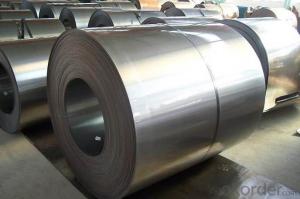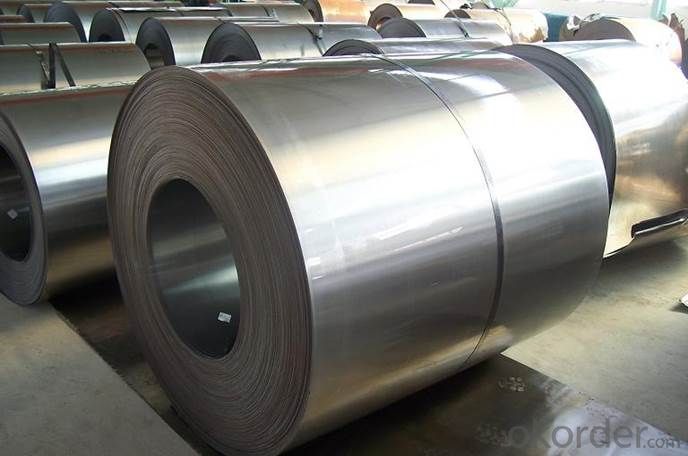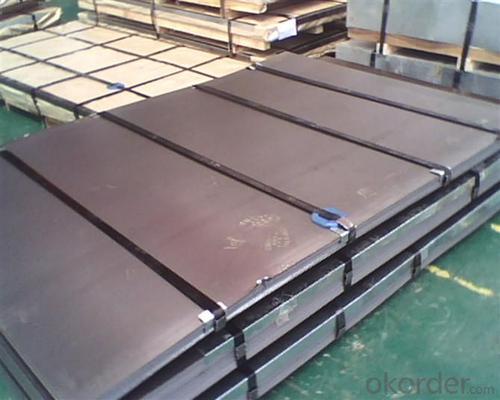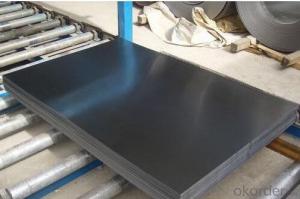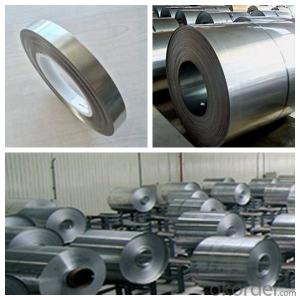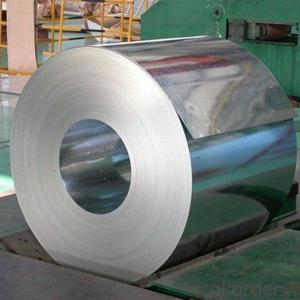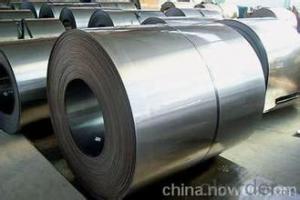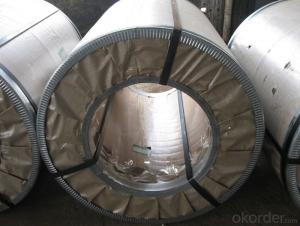China top mill Cold Rolled Steel Coils/Sheets
- Loading Port:
- Tianjin
- Payment Terms:
- TT OR LC
- Min Order Qty:
- 2 m.t.
- Supply Capability:
- 200000 m.t./month
OKorder Service Pledge
OKorder Financial Service
You Might Also Like
Specification
Product Name | Cold Rolled Sheet Coil |
Material | SPCC/SPCD/SPCE/DC01/ST12/ ST14/SPCD/DC03/DC04 ect. |
Grade Standard | JIS G3302, EN10142, ASTM653, ASTM95 |
Thickness | 0.15-3.5mm |
Width | 600mm-1500mm |
Coil ID | 508-610mm |
Coil OD | max 1500mm |
Weight | 3-10 Tons |
Tolerance | Thickness tolerance:+/-0.02mm; Width tolerance:+/-5mm |
Surface | No-skin passed or Skin passed, Tensile leveled |
Surface Treatment | Chromate/Unchromate passivation, fingerprint resistant treatment, oiled/unoiled |
Annual Output | 350,000MT |
Application | Construction, hardware, home applicances, interior decoration |
General Application of Cold Rolled Steel Coil:
Classification | Designation | Characteristics | Main applications |
Commercial quality | SPCC SPCCT | Commercial quality suitable for bending fabrication and simple forming; this is the type in greatest demand. | Refrigerators, cabinets, power distribution baords and drums. |
Drawing quality | SPCD | Drawing quality second only to that of SPCEN. Excellent uniformity. | Automobile floor and roof panels. |
Deep-drawing quality | SPCE SPCF | Deep-drawing quality.With metallurgically controlled grain size, it retains its beautiful finish even after being deep-drawn. | Automobile fenders and quarter panels |
Extra deep-drawing quality | SPCG | Extra-low-carbon steel sheets with highest workability | Automobile internal panels and deep-drawn parts |
- Q: What are the different types of steel coil surface coatings?
- There are several different types of steel coil surface coatings that are used to enhance the durability, corrosion resistance, and aesthetic appearance of the steel. Some of the commonly used coatings include: 1. Zinc Coatings: Zinc coatings are widely used to protect steel from corrosion. Galvanized steel coils are coated with a layer of zinc to provide a barrier against moisture and other environmental elements. 2. Galvannealed Coatings: Galvannealed coatings are a combination of zinc and iron. This coating provides enhanced corrosion resistance and also improves paint adhesion, making it suitable for applications where painting is required. 3. Aluminum Coatings: Aluminum coatings are used to provide a lightweight and corrosion-resistant surface. Aluminum-coated steel coils are often used in the automotive industry for body panels and other parts that require high strength and resistance to corrosion. 4. Organic Coatings: Organic coatings are typically applied as a layer of paint or powder coating. These coatings provide protection against corrosion and also offer a wide range of color options for aesthetic purposes. They are commonly used in the construction industry for roofing and cladding applications. 5. Metallic Coatings: Metallic coatings such as tin, nickel, and chromium can be applied to steel coils to provide specific properties like improved electrical conductivity, increased hardness, or enhanced resistance to wear and tear. 6. Ceramic Coatings: Ceramic coatings are used to provide high-temperature resistance and thermal barrier properties. They are often used in applications where steel coils are exposed to extreme heat or in industrial processes that require thermal insulation. Each type of coating has its own unique properties and advantages, and the choice of coating depends on the specific requirements of the application. Manufacturers and engineers carefully consider factors such as cost, durability, corrosion resistance, and aesthetic appeal when selecting the appropriate coating for steel coils.
- Q: In construction, what types of stress require steel to be placed in footings?
- Steel is always added to concrete to handle local 'tension' stresses. (Sometimes to provide extra compression in 'pre-stressed' applications, but the steel is still in tension.) Steel would be added to the lower section of footings to stiffen them to 'bridge' local 'soft spots' in the substrate.
- Q: i have a white spot on my stainless steel stove, its on the part behind the burners where the oven controls are, does anyone know what it may be and how to remove it. i have tried soap and water and stainless steel cleaner but neither worked. thanks!
- Barkeeper's Friend is the bomb for a metal and fiberglass cleaner, if it can be removed, it will remove it. I have no clue what it is thats on there.
- Q: Can steel coils be reused?
- Yes, steel coils can be reused. They are often recycled and repurposed for various applications in different industries.
- Q: I am buying a knife for my future husband for his wedding gift and I was wondering what is better carbon steel or stainless steel?
- The better grade of stainless is the top choice, but it can be hard to find, and expensive. - Surgical scalpels are made of it. (Common '420' stainless will not hold an edge as well as high carbon steel.)
- Q: How are steel coils inspected for quality assurance?
- Steel coils are inspected for quality assurance through a rigorous process that involves various tests and checks. Firstly, visual inspection is conducted to look for any surface defects such as scratches, dents, or rust. This ensures that the coils are in good condition and free from any obvious flaws. Next, dimensional inspection is performed to verify the dimensions and tolerances of the coils. This involves measuring the width, thickness, and length of the coils to ensure they meet the specified requirements. Any deviations from the standard dimensions are noted and addressed. Additionally, mechanical testing is carried out to assess the strength and durability of the steel coils. This includes conducting tensile tests to measure the strength and elasticity of the steel, as well as impact tests to evaluate its ability to withstand sudden loads or shocks. Furthermore, chemical analysis is conducted to determine the composition and purity of the steel. This involves taking samples from the coils and analyzing them in a laboratory to check for the presence of any impurities or elements that may affect the quality of the steel. To ensure the coils meet specific industry standards, non-destructive testing methods such as ultrasonic testing or magnetic particle inspection may be employed. These techniques allow for the detection of internal defects or irregularities that may not be visible to the naked eye. In addition to these tests, the coils may undergo surface treatment inspections, such as galvanization or coating checks, to ensure the protective layers are applied correctly and meet the required specifications. Overall, steel coil inspection for quality assurance involves a combination of visual, dimensional, mechanical, chemical, and non-destructive testing methods. These comprehensive inspections help to ensure that the steel coils meet the necessary quality standards and are suitable for their intended applications.
- Q: How do steel coils perform in high-pressure applications?
- Steel coils perform well in high-pressure applications due to their strong and durable nature. The high tensile strength of steel allows it to withstand the pressure exerted on it without deformation or failure. Steel coils are designed to maintain their shape and structural integrity even under extreme pressure, making them suitable for use in various high-pressure applications such as hydraulic systems, pressure vessels, and industrial machinery. Additionally, steel coils have excellent resistance to corrosion and high temperatures, further enhancing their performance in high-pressure environments. Their reliability and ability to withstand high pressure make steel coils a preferred choice for industries that require robust and efficient equipment.
- Q: We have a stain from a pot or bowl in our new expensive stainless steel sink. It looks like a water mark that happens when you leave a glass on a table without a coaster. It's a mark in the shape of the bowl or pot that was there. We left it there overnight:( It's not rust either. Help!
- The best product I have ever come across is Barkeeper's Friend. I use the liquid version rather than powdered version. It is a soft soft abrasive scrub designed for stainless steel. I original found it to use it on all my All Clad pots and pans to keep them beautiful and shining. I also have a stainless kitchen now, sink, stove and fridge...and I use Barkeepers on everything. It is fantastic. If you don't want to go out and find Barkeepers tonight, you can get a similar affect using baking soda mixed with dish soap. Make a good paste to gently rub on stains. Be sure to rinse the stainless steel surface thoroughly, and towel dry. If the stains still remain you can try vinegar. Remember to thoroughly rinse and towel dry. But tomorrow go out and get a bottle of BarKeeper's Friend...you will never regret it. UPDATE: just saw a few other answers, DO Not use steel wool (SOS pads) you will scratch the heck out of the finish and you will not be able to fix it.
- Q: What is the role of steel coils in the production of conveyors?
- Steel coils are used in the production of conveyors as they serve as the main structural component for supporting and guiding the conveyor belt. These coils are typically formed into a cylindrical shape and act as a sturdy foundation for the belt to rest on. Additionally, the strength and durability of steel coils ensure that the conveyor can withstand heavy loads and constant movement, making them essential for efficient and reliable conveyor systems.
- Q: What are the challenges in welding steel coils?
- There are several challenges in welding steel coils that need to be addressed in order to ensure successful and high-quality welds. One of the main challenges is achieving proper joint preparation. Steel coils often have different surface conditions, such as rust, scale, or oil, which need to be cleaned or removed before welding. This requires extensive cleaning and preparation to ensure a clean and sound welding surface. Another challenge is the control of heat input. Steel coils are typically thin, and excessive heat can cause distortion, warping, or even burn-through. Welding operators need to carefully control the heat input to prevent these issues and maintain the integrity of the coils. Moreover, the presence of residual stresses is a significant challenge. Steel coils are often subjected to various stresses during manufacturing, transportation, and handling, which can lead to distortion or cracking during welding. Adequate preheating and post-weld heat treatment may be necessary to relieve these stresses and prevent any potential defects. Ensuring proper weld penetration is also crucial. Steel coils may have varying thicknesses, and achieving consistent and adequate weld penetration throughout the joint can be challenging. Welding operators need to choose the appropriate welding parameters and techniques to ensure complete fusion and a strong bond. Lastly, the size and weight of steel coils can pose logistical challenges during welding. Handling large and heavy coils requires specialized equipment and proper positioning to ensure safe and efficient welding. Additionally, the length of the coils may require multiple passes or continuous welding, which demands skilled operators and precise coordination. Overall, welding steel coils requires careful attention to joint preparation, heat control, stress relief, weld penetration, and logistical considerations. Overcoming these challenges ensures the production of high-quality and durable welded steel coils.
Send your message to us
China top mill Cold Rolled Steel Coils/Sheets
- Loading Port:
- Tianjin
- Payment Terms:
- TT OR LC
- Min Order Qty:
- 2 m.t.
- Supply Capability:
- 200000 m.t./month
OKorder Service Pledge
OKorder Financial Service
Similar products
Hot products
Hot Searches
Related keywords
